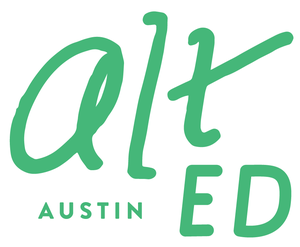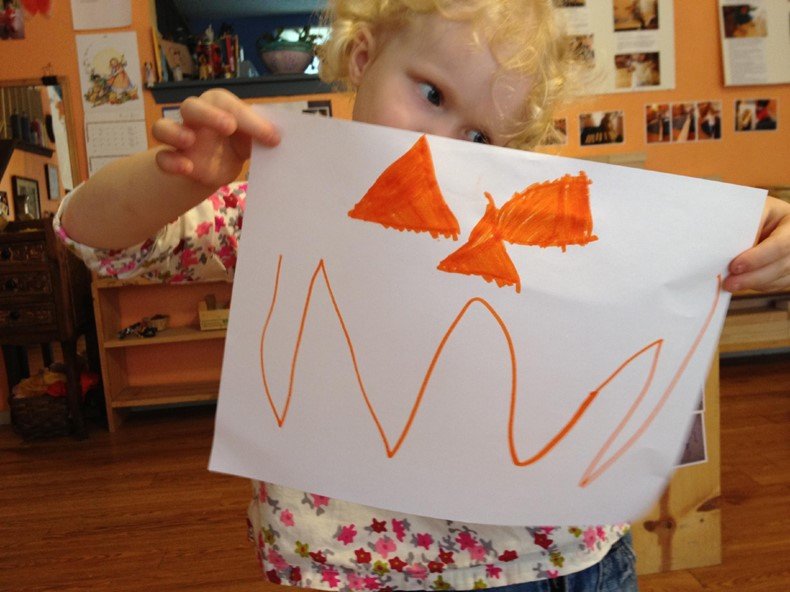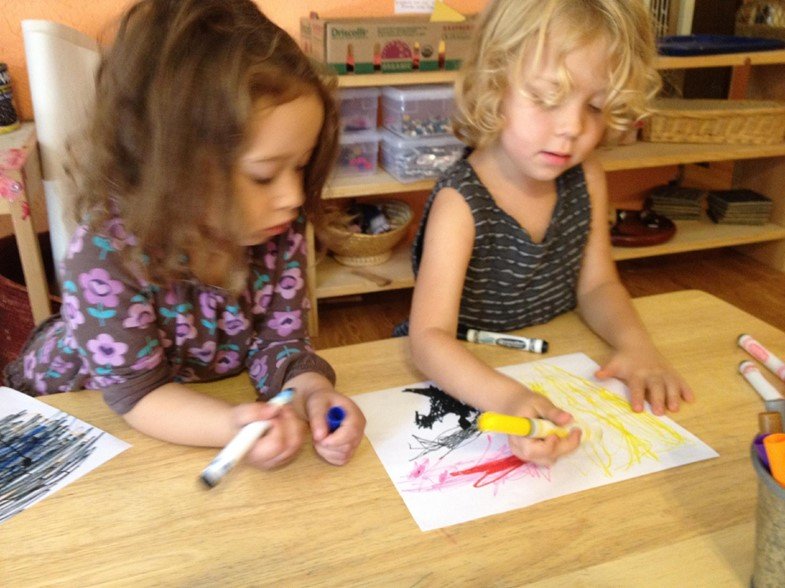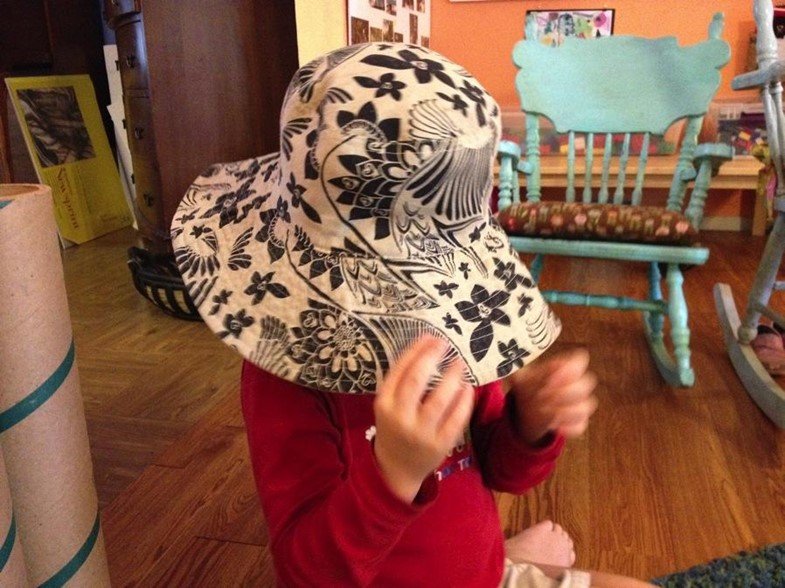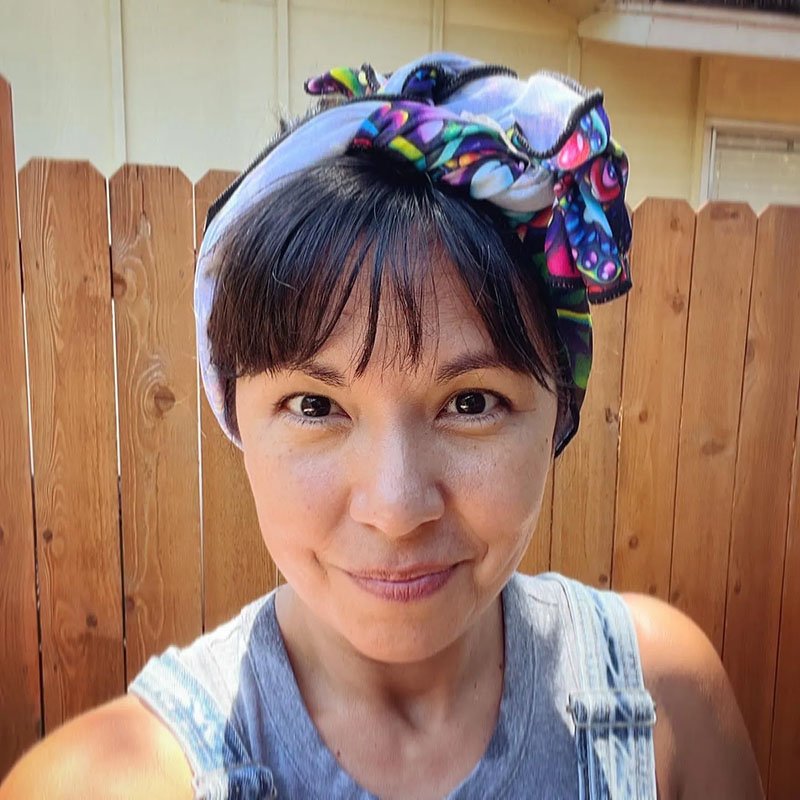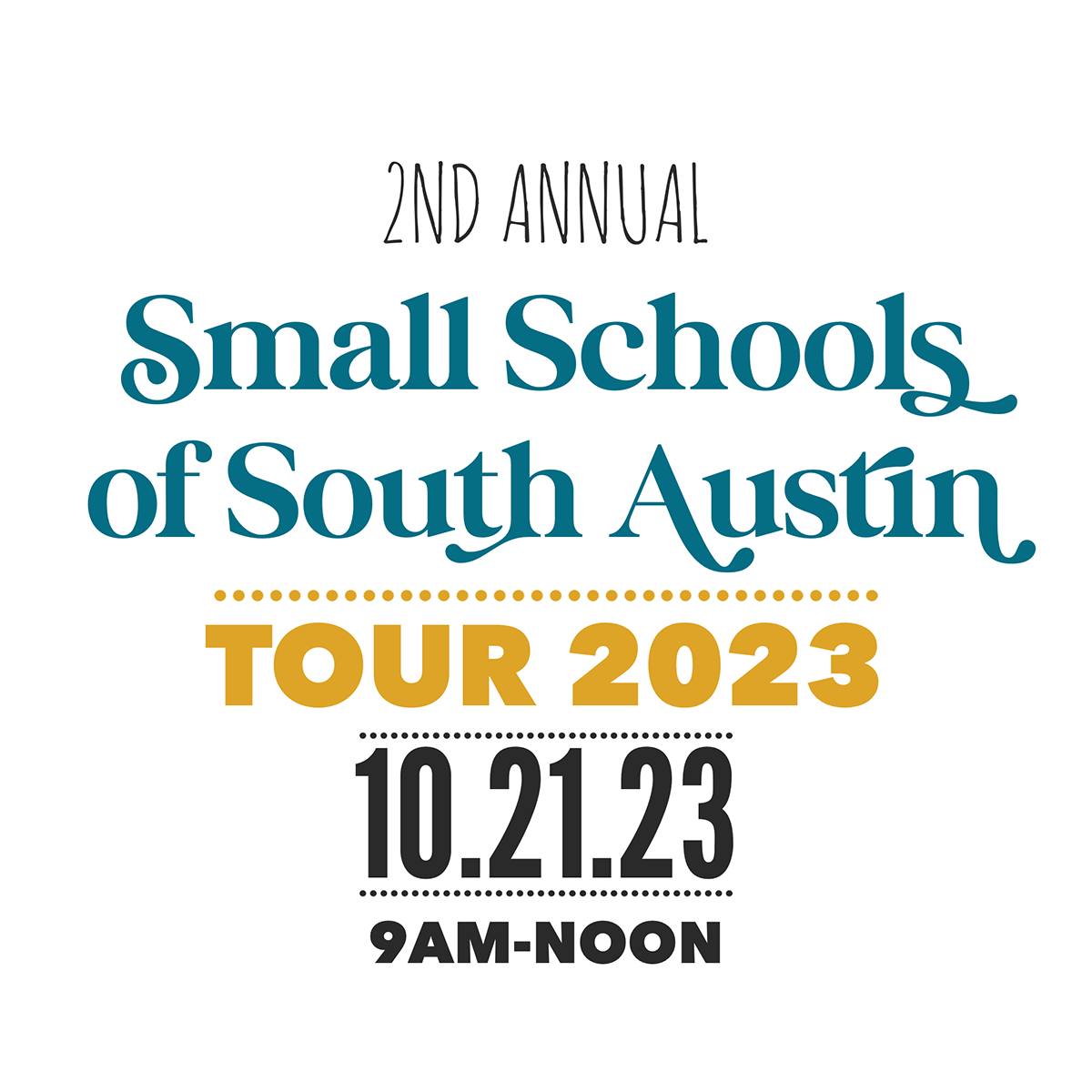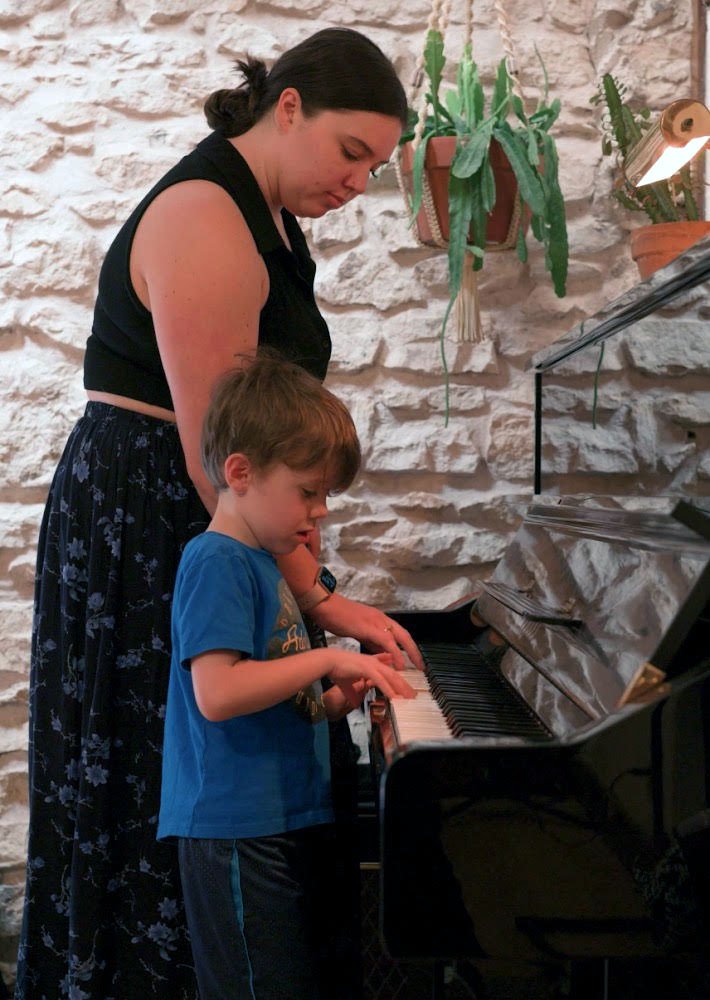When we dress up, do we become someone else? Or do we become more ourselves?
/Marie Catrett, a frequent guest contributor here, has been looking back over ten years of documentation from her work with young children, compiling these stories into a book. She generously turned some of that material into this special photo essay about supporting young children in processing their feelings and questions about Halloween (and “dressing up” in general). Marie is the founder and lead educator at Tigerlily Preschool. You can meet her at this Saturday’s 2nd Annual Small Schools of South Austin Tour.
March 8, 2012
Willa: Is it a ghost or is it just Emerson?
Nayeli: No, it’s Emerson.
Willa: Let’s say boo to him, then the ghost will be Emerson again.
August 28, 2012
A set of magic wands appears in the dress-up corner.
Willa: Marie, what do you want to be turned into?
Marie: Hmm . . . turn me into a butterfly.
Willa: Okay, cause I’m a flying fairy.
Willa waves her wand over me and dances off.
Marie: Now I’m going to be a butterfly?
Emerson: Now not going to be a butterfly. (Emerson waves his yellow wand over me.)
Marie: Did you turn me into something else?
Emerson: No!
I take Emerson to be saying here, “Marie, I need you to be my Marie.” He will often do this when monster play happens if someone in the play begins to refer to me as “the monster coming.” Emerson will tell them no, she’s not a monster, she’s Marie. He will ask me directly, with concern: you’re not a monster, Marie? No, Emerson, I reassure him. I am Marie.
Elias (who finds great meaning in interpreting the world through train talk): We can’t get on this train. This train is too small. We can’t get inside; we don’t have tickets. (His bubble wand is a train.)
Willa: Emerson, what do you want to be turned into?
Emerson: I don’t want to be something.
Willa: Okay. But this is real magic. You could be anything. Even a princess!
Marie (gently): Emerson, I hear pretending. You can choose about if you want any pretending.
Emerson (ponders, then): You could turn me into a BIG princess.
Later during the day
Emerson: (Waves wand): I turn you into a princess Marie.
Marie: Now I am a princess? Are you a princess?
Emerson (spinning happily): No, I’m not a princess. I’m nothing.
Willa: Are you air?
Emerson: No.
Daphne: Are you just Emerson?
Emerson: Yes! Just Emerson!
November 2, 2012
We return to school after Halloween. The children begin telling each other about what they saw.
Marie: There could be more drawing about this, to show what you’re remembering about Halloween?
Yes, the kids say, oh yes, we’ll draw about our Halloween!
Daphne: Me and Daddy maked happy faces for our pumpkins and Mommy made a monkey face. And Mac didn’t carve any because he’s a baby. My pumpkin had fire in it.
Wyatt: I had a scary face of a pumpkin. A vampire face. My pumpkin had its eyes closed. My pumpkin had a triangle eye.
Willa: I saw a lot of shapes in the pumpkin faces on Halloween.
Elias: My pumpkin had a quiet face. I saw a witch. I will draw a witch. With black.
Daphne: I saw a witch! I will draw about a witch too.
Daphne: That’s the witch that I saw on Halloween.
Elias: With a tall black hat on its head!
Nayeli: I saw a spooky house.
Willa: Did you see a real ghost that someone didn’t dress up as?
Nayeli: No.
Willa: Did you see a spider? A monster?
Nayeli: We had to reach in a spider’s web to get candy!
Willa: Was it just a costume spider web?
Nayeli: It was just a pretend spider web with no one inside it. Look how black my picture is.
Willa: Are you making the black night?
Nayeli (adding black lines over the orange ones): It’s making dark orange.
Willa (adding the spooky person, black figure in the lower right corner, with looser black lines, “the black night” wrapping around him, very pleased with the feeling she’s captured): Look what he looks like! When I went trick or treating there was a spooky person wearing all black. Outside. On their porch. He looks like a real haunted. I looked for a dark color to make it. And there was a sunset. I’m making colors because it’s sunset. All sunsets have color. And I make the black night, see? Moon, moon, a bright glittering moon! The moon is gonna be making a yellow sky.
I am struck by how deeply this Halloween stuff matters to the children and make a note to prepare more on this for our next Halloween together.
Here’s what that looked like, one year later.
October 30, 2013
“Me in my Little Red Riding Hood costume and I’m skipping, see? With roses on the basket and candy bread inside.” —Nayeli
Nayeli: Tomorrow is Halloween day.
Daphne: And we’ve been waiting a long time.
Marie: People are thinking about wearing a costume to school tomorrow if they want to. Elias thinks he might be a station master, Nayeli will be Little Red Riding Hood.
Nayan: I will be a giraffe. A costume of a giraffe.
Elias: I will be a costume of a station master.
Marie: And tell your grownups, bring extra clothes. Because maybe you want to be in your costume a long time or maybe you will want to change after a while.
The subject of “What will you be, Marie?” comes up.
Marie: You know, I am usually saying “I will be just Marie” as your teacher, here, when children are pretending.
Dear three-year-old Emerson, you and the other children taught me the importance of this last year!
Nayan: Just wear a little hat.
Daphne: Like with a headband. A headband, and how about different shoes?
Marie: Will you still know that I am me?
Daphne: Wear the same clothes. Your usual clothes.
Marie: If someone is wearing different clothes, are they still the same person?
Daphne: I’ll know everyone because I have really good hearing and really good eyesight.
Nayan: We’ll know you by your talk. Or if you took off your shoes or your hat or your headband.
Nayeli: Marie could be a Marie for Halloween!
Daphne: You just need to put on the same things. If we could go upstairs and see them, we could pick them out for you.
Elias: You have a double-decker house. At night you go upstairs.
Marie: What if I wore a shirt that kids had not seen before, would that feel okay?
Kids: Yes! One we haven’t ever seen before?
Marie (ah ha, I do have an idea now!): Yes. See, I have a new shirt that I just got but you haven’t seen it yet.
Daphne: Like your piano shirt? (There’s a photo of me in some documentation on the wall wearing a concert shirt the children admire.)
Marie: Ah, a little bit like that, yes. But not a piano . . .
Later
Marie: So, we were talking about a costume for me, and people said I should wear shoes, maybe a hat. Here are some different hats of mine.
Nayeli (recognizing my garden hat): This one we know already!
Marie: Yes, you know that one. See the straw hat with the polka dots? This is a hat I like to wear when I go to Barton Springs. It gives me a lot of shade. Now, here’s just regular me, right? And here’s me (putting it on my head) wearing my Barton Springs hat. Am I the same me when I put on the Barton Springs hat?
Daphne: Yeah!
Nayan: ’Cause I see some of your hair.
Daphne: And I see your shoes. Those shoes that I know.
Marie: Ah, ’cause my shoes didn’t change. But you’ve never seen my Barton Springs hat.
Nayan: But I do still know your shoes and your hair.
Nayeli: I would know you even if those shoes were pink.
Nayan: I would still know it was you if your hat was green!
Daphne: I would know you if you were a giant! Because you’re pretty giant.
Marie: What do you think, Elias, is it still me if I put on this hat?
Elias: Yes! It just has this polka dots around your hat.
Nayeli: Your face stays the same. But your face is bigger than ours. Parts of your face is bigger than ours.
Nayan: And my face is smaller than yours.
Daphne: And your hands are bigger than us. Because you’re older.
Marie: Am I the same Marie in my garden hat, in the hat you know?
Kids: Yes! ’Cause of your face and your shoes and the garden hat that we know.
Marie: Okay, and if I take my hat off, here’s just me again. And now here’s the third hat. This is my running hat.
Daphne: Oh, now you look different!
Nayeli: Much different.
Marie: I’m different when I put on the running hat?
Nayeli: But you are the same Marie, though.
Marie: I am the same Marie, but I look different in my running hat.
Nayeli: You look so different in the running hat because there’s no hair coming down.
Kids want to try on my hats.
Daphne: Right now, I can’t see the underneath of the garden hat because I’m wearing it.
Nayan (the Barton Springs hat hangs down over his eyes): Right now, I can’t even see where I am going!
Daphne: And I can’t even see where I am going!
Nayan (laughing): Where am I? This hat kind of looks like a cowboy hat.
Marie: So, tomorrow on Halloween you’re going to see people you know but they might be wearing something different. I’ve never seen Nayeli in a Little Red Riding Hood costume.
Daphne: Have you ever seen me in a butterfly costume?
Marie: I have never seen you in a butterfly costume.
Nayan: Have you ever seen me in a giraffe costume?
Marie: I have never seen you in a giraffe costume.
Daphne: Or in any costume!
Marie: Elias, I have never seen you in a station master costume.
Elias: No . . .
Marie: That is going to be different! Here’s a song I like to teach (holding the Barton Springs hat up over my face).
Who is underneath that hat, hat, hat?
Who is underneath that hat, hat, hat?
All together: Whooooo is it? Marie!
(Marie taking hat away):
I see Marie underneath that hat!
Marie is underneath that hat, hat, hat!
Nayeli: I know that song, I know that song!
We sing many verses, with all our hats, together.
Marie Catrett | Tigerlily Preschool
